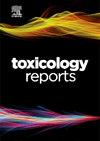Patulin induced neuronal cell damage in human neuroblastoma SH-SY5Y cells
Q1 Environmental Science
引用次数: 0
Abstract
Patulin, a mycotoxin produced by fungal species, is found in fruits and their derivatives. Exposure to it can lead to cognitive deficits and neurodegenerative disorders. Understanding its mechanisms is crucial for assessing risks in food, emphasizing the need for strict food safety regulations to protect public health. In this study SH-SY5Y, a human neuroblastoma cell line was challenged with the mycotoxin patulin. Patulin was treated to the cells for 24 h at 25–2000 nM, concentrations respectively. The results obtained demonstrate the cytotoxicity as assessed by the MTT and LDH leakage assays with an IC50 at a dose of 500 nM. The light microscope images showed a decreased in neurites size with increase in doses of patulin. The patulin treatment showed a decrease in antioxidant enzymes SOD and catalase levels and an increase in ROS and lipid peroxidation levels. Patulin treatment also showed a decrease in mitochondrial membrane potential and mitochondrial damage, with vacuolation of mitochondria visualized by transmission electron microscope. Patulin treatment also showed DNA damage observed by comet assay. The study demonstrates that patulin induces cellular damage, and induces oxidative stress, apoptosis, mitochondrial and DNA damage.
展霉素诱导人神经母细胞瘤SH-SY5Y细胞的神经细胞损伤
棒曲霉素是一种由真菌产生的霉菌毒素,存在于水果及其衍生物中。接触它会导致认知缺陷和神经退行性疾病。了解其机制对于评估食品风险至关重要,强调需要制定严格的食品安全法规以保护公众健康。在这项研究中,SH-SY5Y,人神经母细胞瘤细胞系被霉菌毒素展霉素攻击。展霉素在25-2000 nM浓度下作用于细胞24 h。结果表明,MTT和LDH泄漏试验在500 nM剂量下具有细胞毒性。光镜图像显示,随着展霉素剂量的增加,神经突的大小减小。棒曲霉素处理可降低抗氧化酶SOD和过氧化氢酶水平,增加ROS和脂质过氧化水平。展霉素处理还显示线粒体膜电位降低和线粒体损伤,透射电镜观察到线粒体的空泡化。用彗星试验也观察到展霉素对DNA的损伤。研究表明,展霉素可诱导细胞损伤,引起氧化应激、细胞凋亡、线粒体和DNA损伤。
本文章由计算机程序翻译,如有差异,请以英文原文为准。
求助全文
约1分钟内获得全文
求助全文
来源期刊

Toxicology Reports
Environmental Science-Health, Toxicology and Mutagenesis
CiteScore
7.60
自引率
0.00%
发文量
228
审稿时长
11 weeks
 求助内容:
求助内容: 应助结果提醒方式:
应助结果提醒方式:


